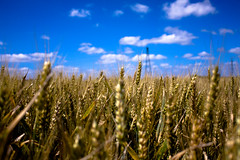Chapter 10 Vocabulary for AP Biology
| 9349056687 | Light Reactions | Occur in thylakoid membrane and are also called light dependent reactions | 0 | |
| 9349056688 | Photosystem | Consists of a reaction-center complex surrounded by light-harvesting complexes which split water to create electrons that get transferred to NADP+ to create NADPH and H+ which are used to create ATP | 1 | |
| 9349056689 | Light-Harvesting Complex | Contains chlorophyll a, chlorophyll b, and carotenoids (within the photosystem) that will trap light energy for use in the light reactions | 2 | |
| 9349056690 | Photosystem 1 | Has P700 chlorophyll a in reaction-center complex, thought to have evolved first because it can work alone to create primary acceptors, 2nd of the photosystems |  | 3 |
| 9349056691 | Photosystem 2 | Has P680 chlorophyll a in reaction-center complex, first of the photosystems. splits water into electrons, oxygen, and hydrogen ions | 4 | |
| 9349056692 | Cytochrome | Protein in the electron transport chain of the photosystems that transfers the electrons to create NADPH | 5 | |
| 9349056693 | Calvin Cycle | Light-Independent reactions Occurs in stoma, does not use light directly. Uses the enzyme Rubisco to create 2 molecules of G3P which is then either used to create glucose or recycled back into RuBP to restart the cycle |  | 6 |
| 9349056694 | Rubisco | The most abundant protein on Earth Carbon Fixation is catalyzed by Rubisco | 7 | |
| 9349056695 | Reduction | The carbon molecules made in Carbon Fixation are reduced into to G3P by adding the negative phosphate from a NADPH that can be used to make glucose or perform other processes | 8 | |
| 9349056696 | 1 Cycle of Calvin Cycle | 1 CO2 is fixed 3 ATP are used 2 NADPH are used 1 RuBP is regenerated 6 cycles needed to make 1 glucose molecule | 9 | |
| 9349056697 | C4 Photosynthesis | A method that bypasses photorespiration Happens in corn, sugarcane, and other plants in hot, dry environments Converts carbon dioxide to a 4-carbon intermediary which is then stored in bundle-sheath cells | 10 | |
| 9349056698 | C3 Plant | Plants that use the Calvin Cycle without creating carbon intermediaries, take in carbon dioxide through stomata. An enzyme called RuBisCO helps the carbon dioxide combine to make sugar. |  | 11 |
| 9349056699 | chlorophyll b | Pigment that absorbs light in the blue and orange light spectrum. Second major pigment used in plants. | 12 | |
| 9349056700 | CAM Plants | Plants that only open stomata at night. They convert carbon dioxide to malic acid which is then converted back into carbon dioxide during the day for the Calvin cycle | 13 |

